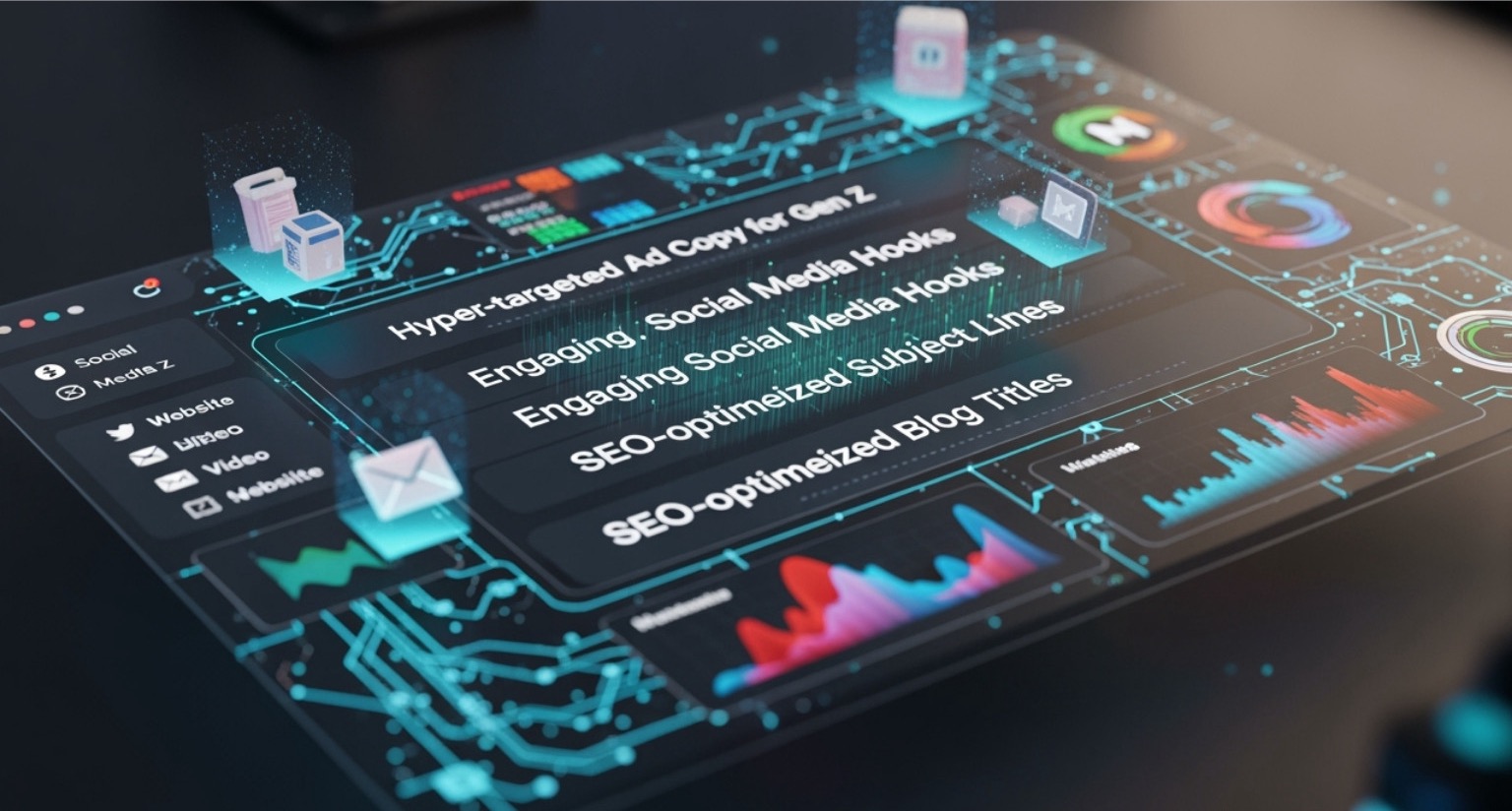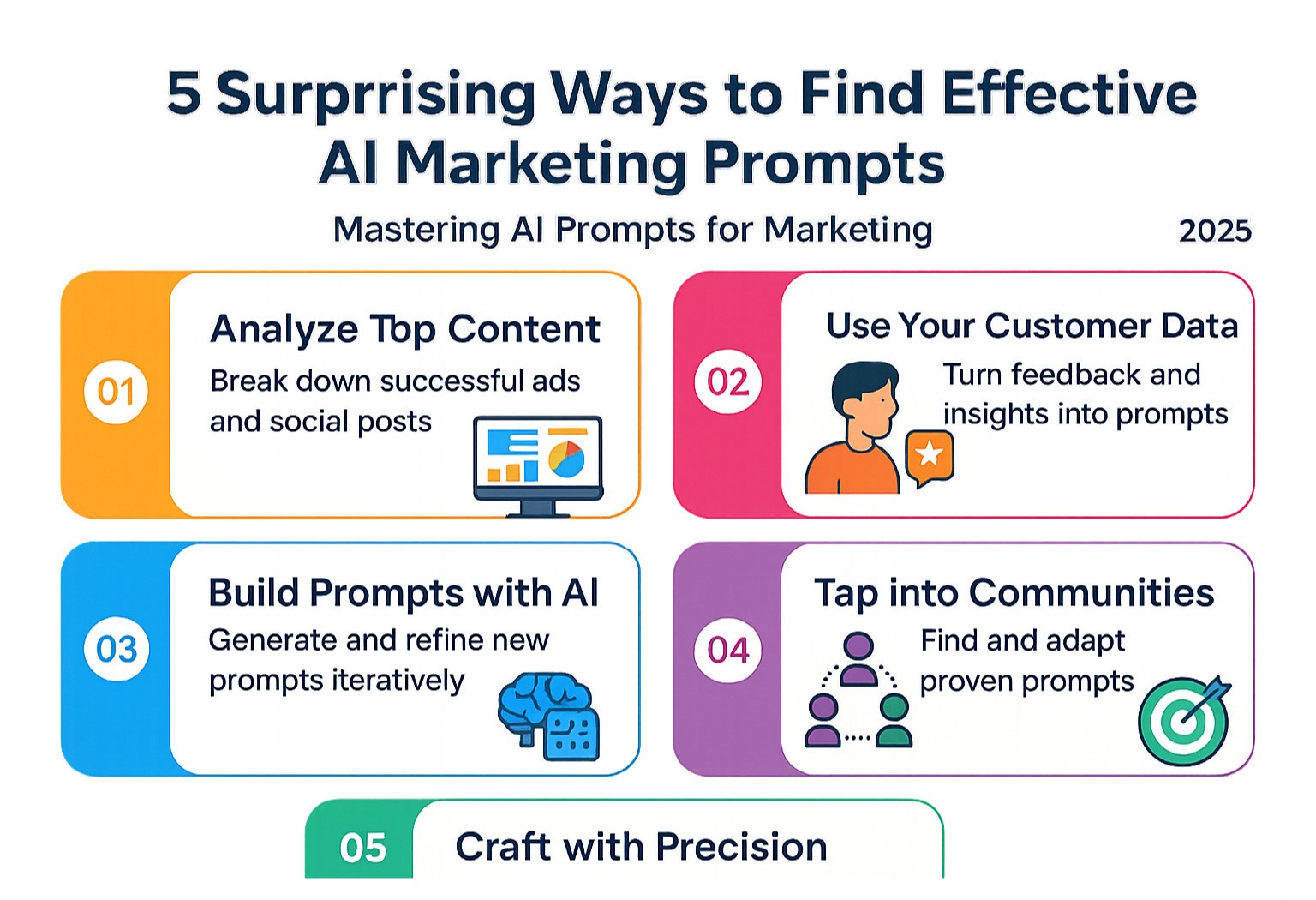5 Surprising Ways to Find Effective AI Marketing Prompts
Mastering AI Prompts for Marketing

Looking for the best ways to get great AI results? Here are five surprising methods to find and create effective AI prompts for marketing:
- Analyze Top Content: Break down successful ads and social posts to see what makes them work.
- Use Your Customer Data: Turn feedback and insights into prompts for personalized marketing.
- Build Prompts with AI: Use AI itself to generate and refine new prompts through iterative steps.
- Tap into Communities: Find and adapt proven prompts from shared libraries and expert groups.
- Craft with Precision: Apply best practices like being specific, giving context, and refining prompts.
Knowing how to use AI prompts for marketing is key. An AI prompt is a command you give to a large language model (LLM) to get a specific response—think of it as giving clear instructions to a smart assistant. These prompts help businesses create content, boost efficiency, and gain a strategic advantage. With 77% of marketers already using AI, leveraging it is a must for staying competitive.
But not all prompts are created equal. Many marketers struggle to get the best results, wasting time with trial and error on prompts that don’t hit the mark. They also often lose track of their best prompts across different tools. This guide will show you how to find and create truly effective prompts, changing your marketing efforts by making your AI tools work smarter for you.

1. Analyze High-Performing Content for Prompt Inspiration
One of the most effective ways to create powerful AI prompts for marketing is by deconstructing what’s already working. This isn't about copying; it's about understanding the structure, tone, and persuasive techniques in top-performing content. By analyzing successful campaigns, ads, and social posts, you can reverse-engineer them into actionable prompts for your AI tools.
This approach is invaluable for market research. Instead of manually sifting through competitor content, you can task an AI with summarizing marketing strategies, identifying common themes, or even performing a SWOT analysis of your main competitors. This saves hours and provides data-driven insights. For example, a prompt like "Summarize the key marketing strategies used by the top three competitors in the organic food sector" can yield powerful insights quickly.

Deconstruct Winning Ad Copy and Social Posts
Ever wonder what makes an ad or social media post go viral? AI can help dissect these successes. Feed examples of winning ad copy into your AI and ask it to identify key elements like the hook, call-to-action (CTA), and emotional appeal.
For instance, you can use AI to "generate three ad copy variations for our new product, targeting young professionals, inspired by the tone and structure of this successful ad." This allows you to create compelling copy and generate multiple variations for A/B testing, significantly improving campaign optimization. Similarly, for social media, you can prompt your AI to "create three engaging LinkedIn posts to promote our upcoming webinar, adopting a professional yet relatable tone."
Create Powerful Prompts for SEO and Content Optimization
Analyzing high-performing content is also crucial for SEO. A prompt like "Generate a list of 20 high-traffic, low-competition keywords related to sustainable fashion" can kickstart your content strategy.
Once you have keywords, AI can help generate SEO-friendly meta descriptions, ensuring they are concise, compelling, and keyword-rich. AI can also generate detailed blog outlines with H2 and H3 subheadings, ensuring your content is well-structured. This helps create content that connects with your audience by directly addressing their needs.
2. Mine Your Own Customer Data for Hyper-Personalization
Your customers are constantly sharing what they love, what frustrates them, and what they need through reviews, purchase patterns, and feedback. The challenge is turning this goldmine of information into actionable AI prompts for marketing.
With 65% of customers expecting businesses to adapt to their preferences, personalization is essential. AI can help you listen at scale, spotting patterns and insights that would take humans weeks to uncover. Every customer interaction—from a purchase to a support ticket—is a roadmap to creating marketing that resonates.

Turn Customer Feedback into Marketing Gold
Instead of manually reading hundreds of reviews, use AI prompts to do the heavy lifting. Start with sentiment analysis by asking AI to "analyze the emotional tone of our last 50 customer reviews and identify the top 3 things customers love most about our product."
Then, use AI to identify pain points by prompting it to "review our customer support tickets from the past month and summarize the most common complaints." These pain points become the exact problems your marketing can address. You can even generate case study frameworks by asking AI to "create a customer success story template based on how we solved a common shipping issue for our customers, including their challenge, our solution, and the results."
Develop Effective AI Prompts for Marketing Personalization
Now, turn those insights into marketing that feels personal. This is where AI prompts for marketing truly shine.
- Targeted email campaigns: Prompt AI to "write a personalized product recommendation email for customers who bought running shoes in the past 3 months, suggesting complementary accessories."
- Customer segmentation: Ask AI to "group our customers into distinct categories based on their buying patterns, frequency of purchases, and product preferences."
- Personalized ad copy: Prompt AI to "create Facebook ad variations for our new yoga class targeting busy moms, incorporating the language and concerns they expressed in our customer surveys."
- Customer retention: Use prompts like "design a re-engagement email for customers who haven't purchased in 90 days, addressing the top reasons for churn we identified in our exit surveys."
This approach doesn't replace human insight—it amplifies it. AI helps you scale your customer knowledge across every touchpoint, resulting in marketing that feels like helpful, timely advice.
3. Use AI to Build Better AI Prompts (Prompt Chaining)
What if one of the best ways to find amazing AI prompts for marketing is to let AI help you create them? This technique is called "prompt chaining" or "meta-prompting." Instead of just asking the AI to do a job, you ask it to think like a prompt expert and help you write better instructions. This turns prompt engineering into a team effort between you and the AI.
AI can help overcome prompt writer's block by generating diverse ideas, suggesting new angles, and spotting weaknesses in your initial thoughts. This iterative process, where you refine your instructions based on the AI's feedback, is like sculpting—you keep shaping the prompt until the output is exactly what you want.

Start with a "Master Prompt" to Generate Expert-Level Prompts
The secret sauce is the "Master Prompt"—an instruction that tells the AI to create other fantastic prompts for you. You can tell the AI to act as an expert in any marketing area, like an SEO strategist or an email marketing guru, and then ask it to generate prompts from that expert's perspective.
Here’s an example of a Master Prompt:
"Act as a prompt engineer and expert SEO strategist. Your goal is to generate 5 expert-level AI prompts for marketing focused on content optimization. For each prompt, include:
- A summary of how elite SEOs think and what makes them successful.
- A winning mental model or key strategy with real-world lessons.
- The actual prompt text written as if an advanced pro is using it.
- An explanation of why this prompt works so well."
This meta-prompt taps into the AI's vast knowledge to generate strategy-focused prompts that follow best practices. It’s like having a team of marketing consultants on call, ready to help you build a collection of expert-level prompts.
Refine Outputs with Iterative Follow-Up Questions
Once the AI generates a response, the next step is iterative refinement. This is where you provide more details, add constraints, and ask follow-up questions to perfect the output. The best prompts are specific, clear, and provide plenty of context. Use examples, set clear goals, and always be willing to tweak and improve.
For example, if the AI generates a prompt for a social media post, you could follow up with:
- "Refine this prompt to produce a more humorous tone."
- "Add a constraint that the output must be under 280 characters and include three relevant hashtags."
- "Generate three different versions of this prompt, each targeting a different customer emotion."
- "Explain the reasoning behind the call-to-action in the prompt. How does it align with best practices for our target audience of tech startups?"
This conversational back-and-forth helps you weave in your brand voice and strategic goals, ensuring the AI produces highly customized and effective marketing content. The better your input, the better your output.
4. Leverage Collaborative Prompt Libraries and Community Resources

Why start from scratch when a community of experts is already sharing their best ideas? Reinventing the wheel is inefficient, especially when others have already found proven formulas. Prompt engineering is no longer a solo journey; it's a team sport. By tapping into the collective intelligence of other marketers, you can save time and get better results.
This is where the magic of a community approach comes in. Our platform, Potions, is a community-powered marketplace where you can find, remix, and evolve the very best AI prompts for marketing. We believe the most effective prompts are polished and perfected through shared effort and collective insight.
How does this collaborative approach change the game?
First, you can instantly search hundreds of proven prompts that other marketers have already tested and fine-tuned. This gives you a massive head start, whether you need to craft ad copy, write email subject lines, or plan seasonal campaigns.
Next, you have the power to remix and evolve ideas. Grab a successful prompt and easily tweak it to fit your brand’s voice and specific audience. It’s more than copying; it’s about taking a great starting point and making it uniquely yours.
Finally, a key feature is robust version control and stable URLs. Every prompt is automatically saved with a version history and a permanent link. This makes it easy to track changes, experiment without fear, and build upon what others have done.
This shared environment turns prompt engineering into a collaborative craft. When you share your improvements, you enrich a growing library of AI expertise for everyone. This teamwork frees up human marketers for more strategic, creative thinking while AI handles repetitive tasks. By embracing community-powered prompt libraries, you can accelerate your marketing efforts, achieve higher-quality results, and stay ahead in AI-driven marketing.
Frequently Asked Questions about AI Marketing Prompts
As we explore AI prompts for marketing, several questions naturally come up. Let's tackle the most common ones to help you feel confident using AI in your marketing.
What are the best practices for crafting effective AI prompts?
Creating great prompts is like giving clear directions. The more specific and thoughtful you are, the better the results. Here are the key best practices:
- Be Specific and Clear: Instead of a vague request like "write about marketing," ask for "a 500-word blog post on how AI can help local bakeries grow their online presence, using a friendly tone."
- Provide Context: Give the AI background information. Who is your target audience? What is your business goal? What is your brand voice?
- Define the Persona: Tell the AI what role to play, such as "Act as an experienced digital marketing consultant writing for a small business owner new to AI."
- Set Constraints: Be clear about your desired output. Specify word counts, formats, or goals, like "Generate 10 blog post titles, each under 70 characters."
- Iterate and Refine: Treat the first result as a starting point. Use follow-up questions to refine the tone, add a stronger call to action, or request different variations.
- Use Examples: If you have a style in mind, show the AI. For instance, "Write a social media caption with a similar style and tone to this successful post I created last month."
Can AI completely replace human marketers?
No, AI cannot completely replace human marketers. Instead, AI is an incredibly capable partner that handles repetitive tasks, freeing you to focus on strategy and creativity. AI excels at analyzing data and generating content variations at scale, but it lacks the human creativity, strategic intuition, and emotional intelligence that make marketing truly effective.
Your role as a marketer becomes more valuable. You shift from being a content generator to a strategic thinker and prompt engineer who guides the AI. You bring the ethical considerations, brand values, and ability to build authentic connections that only a human can.
How can small businesses start using AI prompts for marketing?
Getting started with AI prompts for marketing doesn't require a huge budget. You can begin in simple, practical ways.
Start with free tools like ChatGPT, Claude, or Gemini to experiment without financial commitment. Focus on one area first, like social media content or email subject lines, to see results quickly. Begin with simple prompts and gradually work your way up to more complex requests as you get comfortable.
Here are some beginner-friendly tasks where AI can make an immediate difference:
- Content Creation: "Suggest 10 blog post ideas about sustainable living that would appeal to millennials."
- Campaign Brainstorming: "Suggest three creative marketing campaign ideas for our new line of eco-friendly cleaning products for the spring season."
- Market Insights: "Summarize the key themes from these 20 customer reviews to quickly understand customer sentiment."
- Customer Retention: "Write a short, friendly re-engagement email for customers who haven't purchased in 6 months, offering a special discount."
The key is to start small, focus on specific tasks, and build your confidence with AI as your marketing partner.
Conclusion: Transform Your Marketing with Smarter Prompting
We've walked through five game-changing approaches to finding and crafting powerful AI prompts for marketing: analyzing top content, mining customer data, using AI to build better prompts, tapping into community wisdom, and mastering precise prompt crafting.
The future of marketing isn't just about using AI; it's about becoming smarter with how we use it. The secret lies in understanding that better inputs create better outputs. When we provide clear context and strategic direction to our AI tools, we open up new levels of efficiency and creativity.
This shift allows us to focus on the deeply human aspects of marketing—strategic vision, emotional connection, and brand storytelling. AI handles the heavy lifting while we concentrate on what humans do best: understanding people and creating meaningful experiences. Using AI prompts for marketing is no longer just a competitive advantage; it's essential for staying relevant.
This isn't a solo journey. Prompt engineering works best as a collaborative craft. When we share insights and build on each other's successes, everyone wins.
Ready to see what happens when you combine smart prompting with community wisdom?